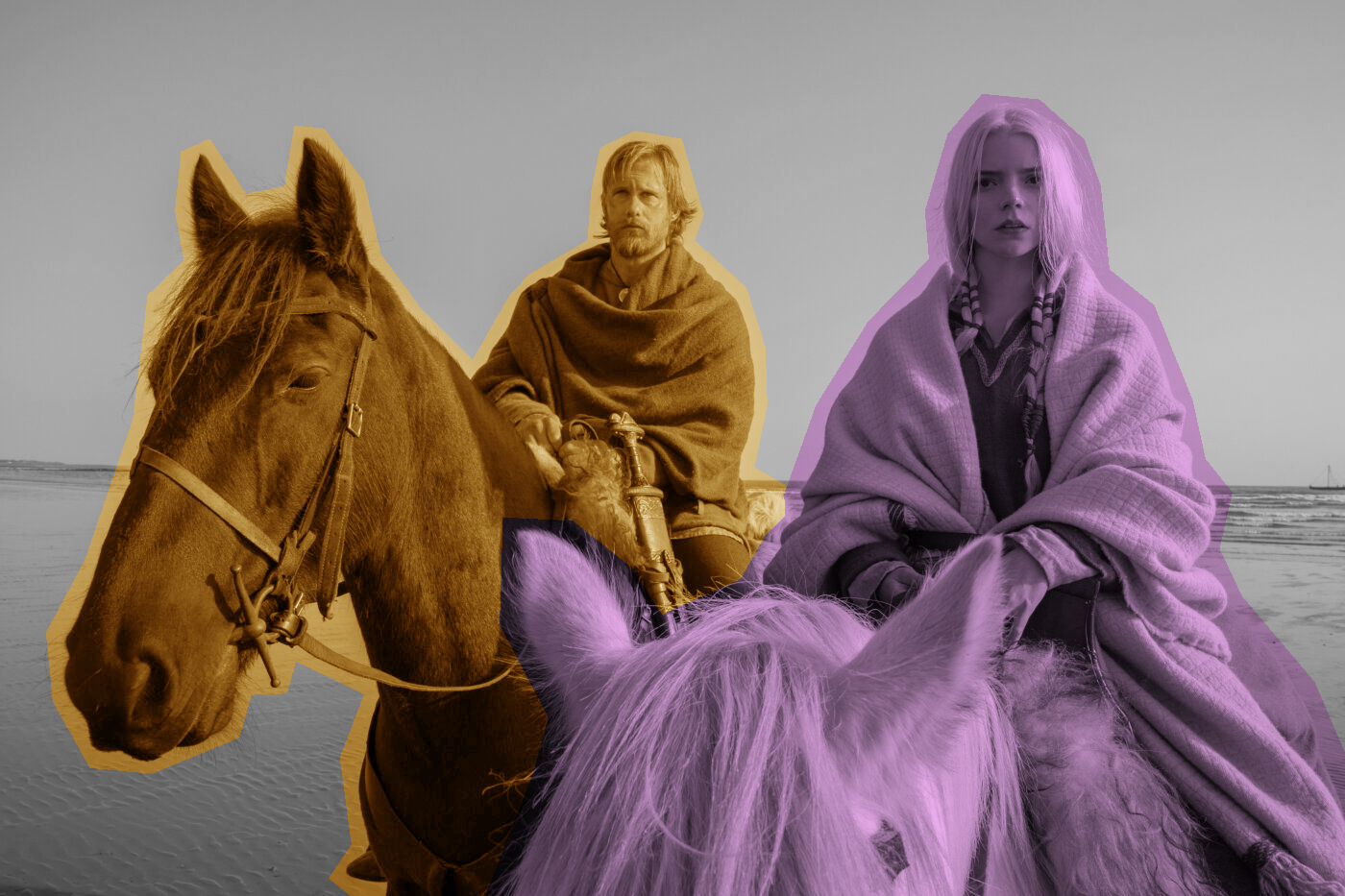THERE WILL BE SPOILERS
The Northman (2022) is the newest film by Robert Eggers, of The Witch (2015) and The Lighthouse (2019) fame. Lesser known are his short films, all of which are available on YouTube – Hansel & Gretel, a silent piece shot in black and white that conjures up a very chilling atmosphere; The Tell-Tale Heart, based on Edgar Allan Poe’s short story; and Brothers, a “Cain-and-Abel tale.”
Both his long and his short movies share a very distinct filmmaking view. Eggers works with historical settings and constructs the worlds of his movies as if happening within the mindset of their respective time periods.
What his means for The Northman is that we are cast upon a world where Norse mythology is very real indeed, and elements such as Odin’s ravens and Valkyries are a matter of fact, something akin to the weather, and never a break from reality.

The Northman’s story is inspired by the legend of Prince Amleth, which is first found in the Gesta Danorum, a XIII-century collection of tales weaving a partly mythical account of the history of Denmark. Amleth’s tale itself is probably based on an earlier Icelandic folk story; Shakespeare would later base his Hamlet on it.
According to Eggers, The Northman is his attempt to “do Conan the Barbarian (1982) by way of Andrei Rublev (1966).” Watching the movie, it definitely feels like such a straightforward revenge story could have been quite unremarkable in the hands of a lesser director (Conan is definitely camp), but Eggers carries Amleth’s tale beautifully.
Another influence that has been established is Ingmar Bergman’s The Virgin Spring (1960), also a revenge tale set in the Middle Ages, in Sweden this time around. In fact, the first words of the movie are “Odin, come” – and, as we’ll see, Odin is a very relevant presence in The Northman.
The film starts in the fictional kingdom of Hrafnsey or “Raven Island”, supposedly located somewhere between the Orkney and the Shetland Islands, in the North of Scotland. Amleth is a child awaiting that his father, King Aurvandil, returns from battle.

It is not unusual in polytheistic religions that one god takes precedence over another in certain regions or communities, and in this case, Eggers establishes from the get-go that King Aurvandil (“the war Raven”) and his people worship Odin as their preferred god.
Now, in Norse mythology, Odin has two ravens that roam the realm of men and carry its news back to him, and we can actually see how ravens accompany the King’s ships back home.
In fact, ravens appear throughout the film as manifestations of Odin and they can be seen observing how the story unfolds. In one pivotal scene, Odin himself intervenes on Amleth’s behalf and has his ravens free him from captivity.
On the other hand, Fjölnir, Amleth’s uncle and the movie’s main antagonist, prefers Freyr as his main god of worship. The fact that King Aurvandil and Fjölnir worship different gods even though they are family goes on to show how their relationship was truly strained.
Also, Fjölnir is more of a farmer type, rather than a warrior, so it makes sense for him to be partial to the god of fertility. Amleth mocks his choice by calling Freyr “a god of erections.”
This concept of sibling rivalry is very central to Norse mythology too. In ancient times, two groups of deities were supposed to have fought a war before joining forces and creating an integrated pantheon. Odin belonged to the first group (Æsir), whereas Freyr belonged to the second (Vanir).
Back to King Aurvandil’s return, there is a small scene in which Amleth runs to his mother in order to tell her the news that has more to it that meets the eye in light of later events in the film. Amleth storms her chambers only for her to become angry at him, rather than happy about her husband’s coming home.
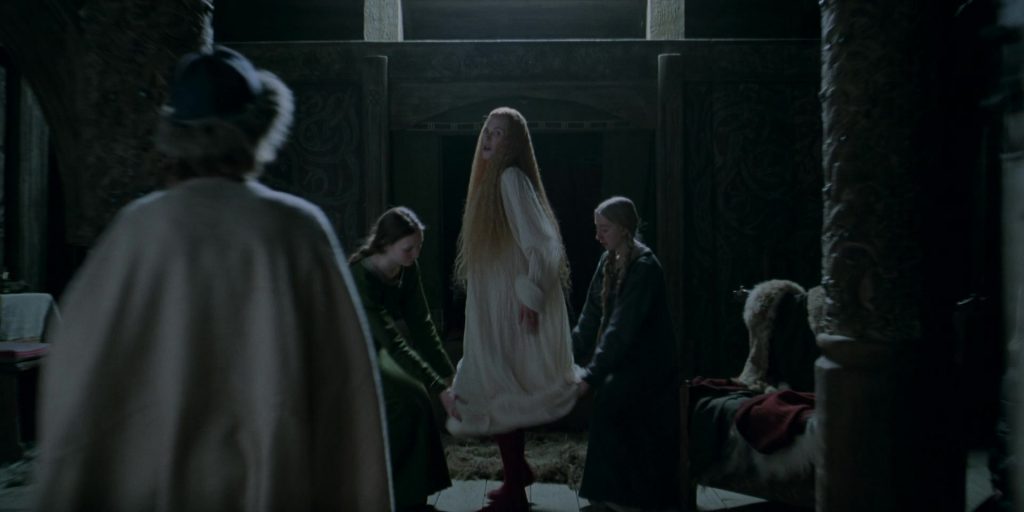
While Queen Gudrún has been telling her son that she is a princess from Brittany, the truth is that she was a slave girl raped by the King who was later “promoted” to Queen status after bearing him a son.
When Amleth bursts into her chambers as she is getting dressed, the Queen flares up at the idea that her son might see that she’s been iron-branded as a slave, thus discovering the truth. Also, as she will later suggest during a deranged scene with a top-notch performance by Kidman, her feelings towards him are muddled – she is not sure whether she loves or hates him.
As much as Amleth adores his father, we are privy to some details here and there that let us start to suspect that King Aurvandil is not so great as his son thinks. The first indication thereof is the train of enslaved people that he has brought to his kingdom, a moment that lets a chill run down your spine.
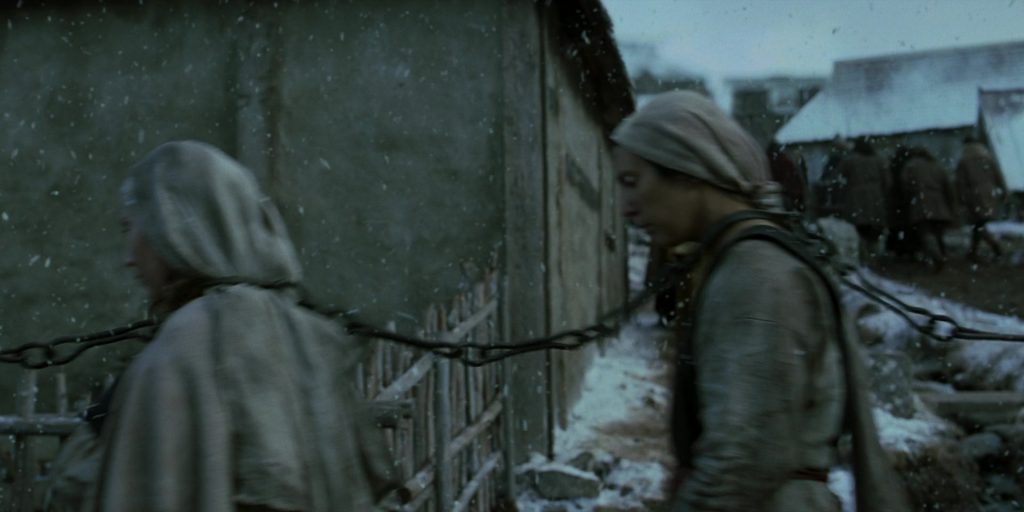
Not so easy to catch is Queen Gudrún’s headpiece, which is actually of Finnish origin, not Scottish. It is implied that it had been plundered at some point in the past. The King also gifts Amleth a necklace that he took from a dead prince.
This piece of heirloom foreshadows Amleth’s own death at the end of the movie, as the necklace goes from one dead prince to another. The necklace will later be seen around Amleth’s daughter’s neck as well.
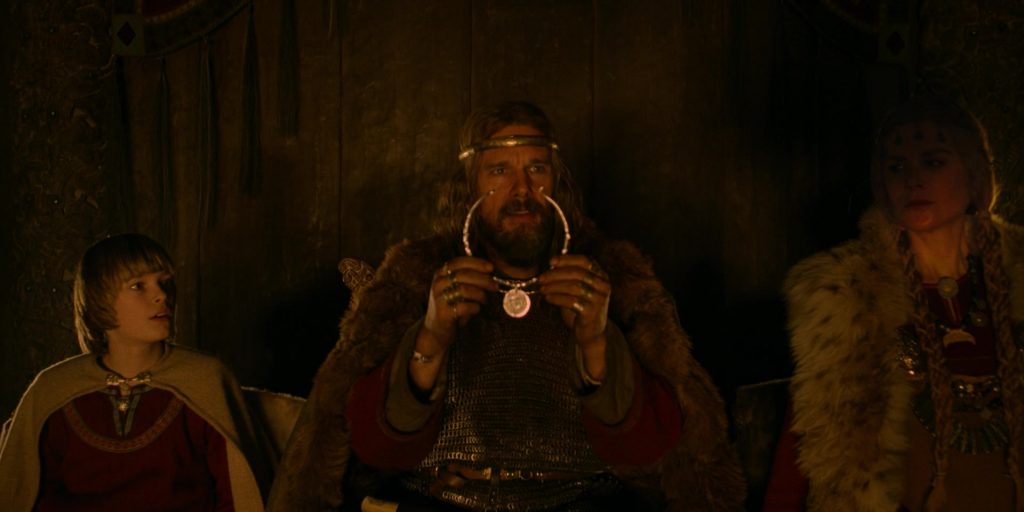
Through this and other small moments, it can be argued that Eggers has included a small commentary on the perpetuation of violence as part of his revenge tale. Is he implying that Amleth’s daughter will also become a victim of violence? Amleth will go on to have a son and a daughter, but she is the one wearing royal regalia. Do these kids replicate the sibling rivalry between King Aurvandil and his brother Fjölnir?
Vikings apparently had one of the most “egalitarian” societies of their time – but let’s take that with a grain of salt. I am definitely not an expert on the subject, but I wonder whether women’s better-off status in Viking society would actually go as far as to mean that they would have taken precedence in the line of succession to the throne.
Elaborating a bit further into the perpetuation of violence aspect – when Amleth becomes a slave as part of his quest for vengeance, one of the slaves tells him not to even consider running away, as there is nowhere to run to. However, when Amleth frees the slaves towards the end of the movie, they burn everything down in a rage against their captors.
It is probably not the smartest move, but such are the consequences of violence – suffering and pain for everybody with little sense to be made out of it.
Back to the banquet scene, there are a couple of details worth noting. Firstly, King Aurvandil can be seen sitting with his sword across his lap. As the stickler for detail that he is, Eggers actually based this posture on a chess piece dug up on a beach in the Outer Hebrides in 1831.
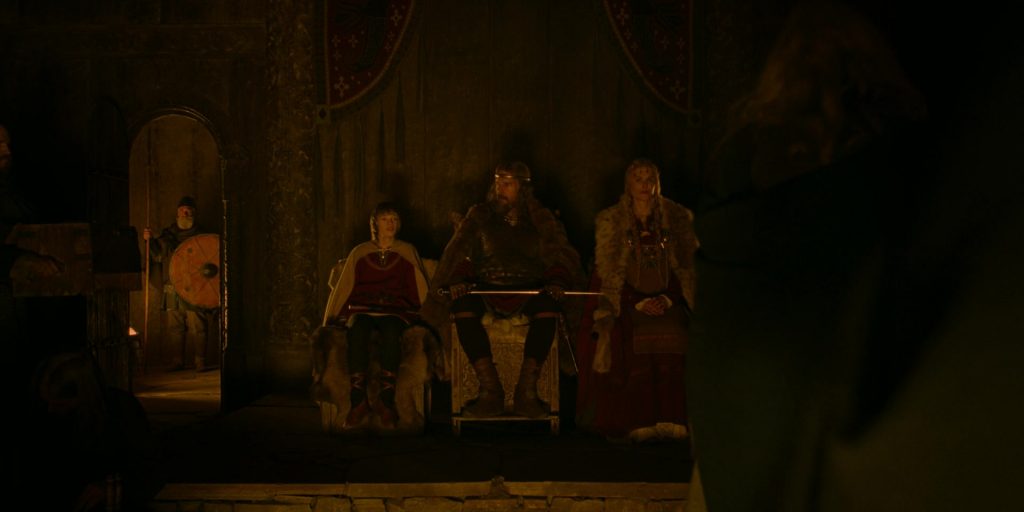
Secondly, and more relevant to the plot, Queen Gudrún shows herself to be overtly friendly to Fjölnir – something that goes not unnoticed by the court’s fool, Heimir, who remarks on it. Everyone’s reactions are very telling: King Aurvandil seems unfazed, but Fjölnir gets mad and threatens Heimir, defending the Queen’s honor.
Queen Gudrún and Fjölnir are of course having an affair, and King Aurvandil remains completely oblivious to it. She has asked Fjölnir to kill both her husband and her child, an action that will set in motion the events of the movie.
For now, though, she pretends that all is well. The royal couple have a short get-together where we see that King Aurvandil has been seriously wounded in battle, but he is not too worried about it.
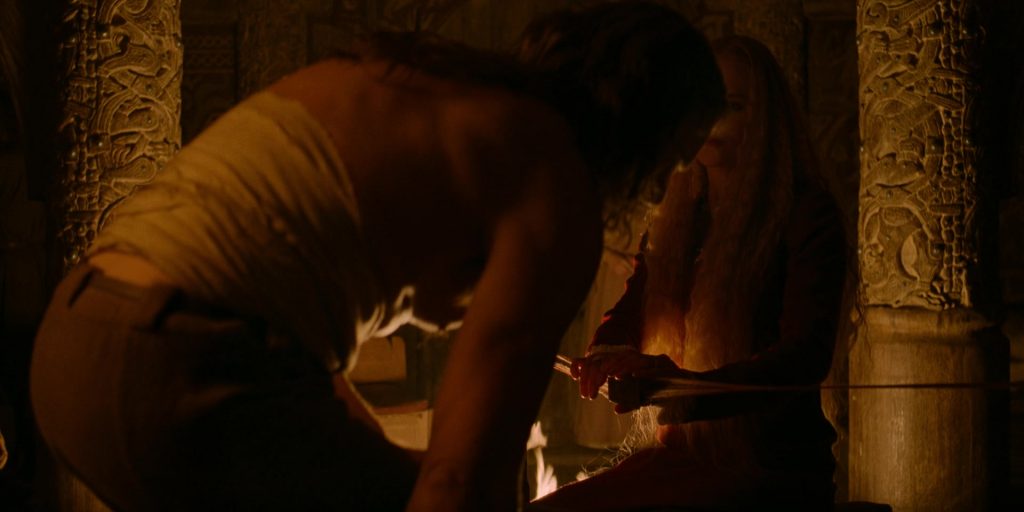
In fact, as an Odin worshiper, it is his wish to die in battle. In Norse mythology, warriors who died bravely in battle were taken to Odin’s hall, Valhalla, by the Valkyries, Odin’s female warriors. And this being a Robert Eggers film, that is as good as done – when the time comes, it WILL happen.
Valhalla was not the only possible destination after death for Vikings, however. Following in the original division in the pantheon, Freyja worshippers would go to Fólkvangr, a meadow or valley of sorts.
We are treated to some more information on the Vikings’ world view in the next scene. Feeling that his son is still too childish, King Aurvandil takes him to a shamanic ritual where he will learn about his place in the Viking cosmos. It is somehow ironic how the King does not realize that he is also unable to see the reality of things and how his own position is all but secured.
As for the ritual, Heimir the Fool happens to double as a shaman here. He makes the King and his son inhale the smoke of henbane seeds, which has hallucinatory properties. Shamanism was a very important element of Viking culture, and through it you were supposed to “experience” the world of spirits actively, rather than just worship it passively from a distance.
In this case, their spirit guide is a dog, so that King Aurvandil and Amleth behave as such during their trance. Heimir gives them something to drink that helps then have a vision – the drink is possibly some sort of mead similar to the Mead of Poetry or Mead of Suttungr.
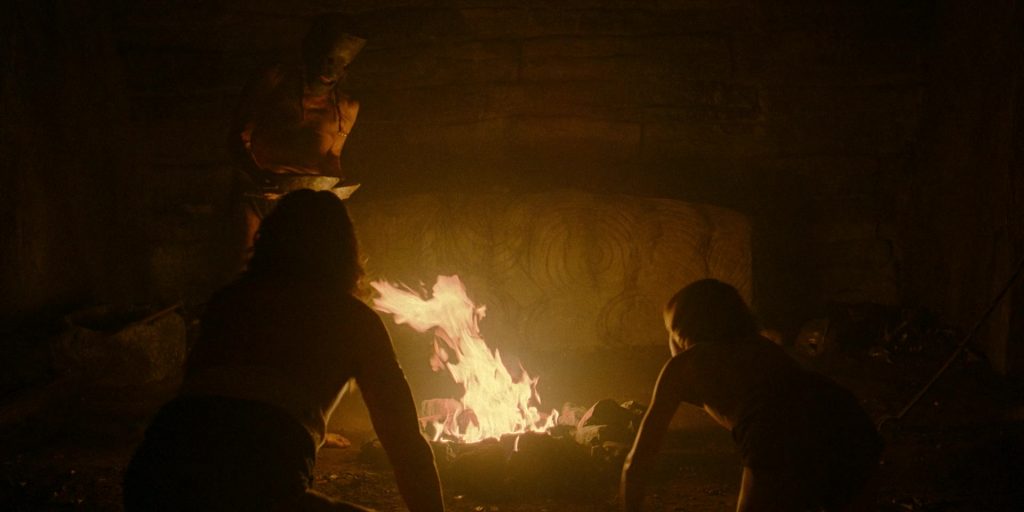
What is that, you say? According to legend, when the gods decided to join hands and call it a truce, they created a man named Kvasir, who was the wisest man in the world, out of their peace-making spit.
Kvasir was a poet, and could answer any question posed to him. Unfortunately, his knowledge did not help him very much, and he was murdered by two dwarf brothers who took his blood and mixed it with honey, thus creating the Mead of Poetry, which would turn anyone who drank it into a scholar.
After drinking the mead and touching his father’s open wound, Amleth has a vision of his own place in the cosmos. He sees the Tree of Kings, from which all the kings that have preceded him up to this point in the line of succession are hanging.
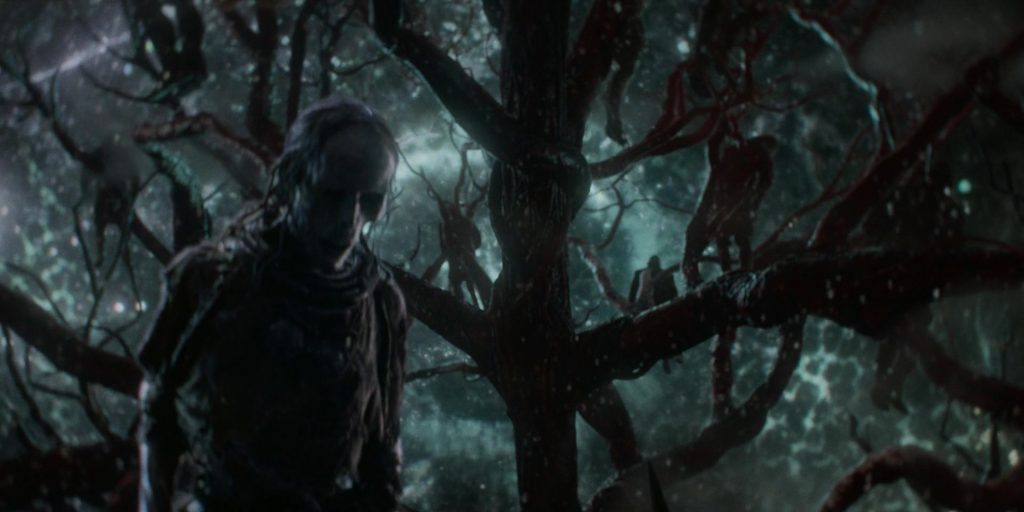
This tree is actually based on Yggdrasil, which Vikings considered to be the center of the cosmos. Yggdrasil connected the nine realms, the most important of them being Asgard (realm of the gods); Midgar (realm of men); and Nilfheim (realm of darkness).
The reason for the hanging iconography goes back to a legend regarding Odin – as we have seen, the main god of worship for Amleth’s kin.
Odin had a great thirst for knowledge and wished to learn the runes, that is, he wished to learn how to read and write. In order to prove his worth, he hanged himself from Yggdrasil for nine days and, after this ordeal, the runes “revealed” themselves to him.
So Amleth learns his place in the cosmos and further cements it by making a pledge to avenge his father should something happen to him. As we have seen, King Aurvandil is set on dying in battle, so this promise has very real implications for Amleth. The shaman produces a tear amulet that symbolizes the last tear Amleth has shed in innocence, and promises that it will be given back to him in his moment of need.
Those are indeed Amleth’s last moments of innocence, as Fjölnir will kill his father immediately afterwards. Amleth manages to flee on a boat after witnessing her mother being taken to his uncle as his new Queen. He promises to fulfill his oath of vengeance.
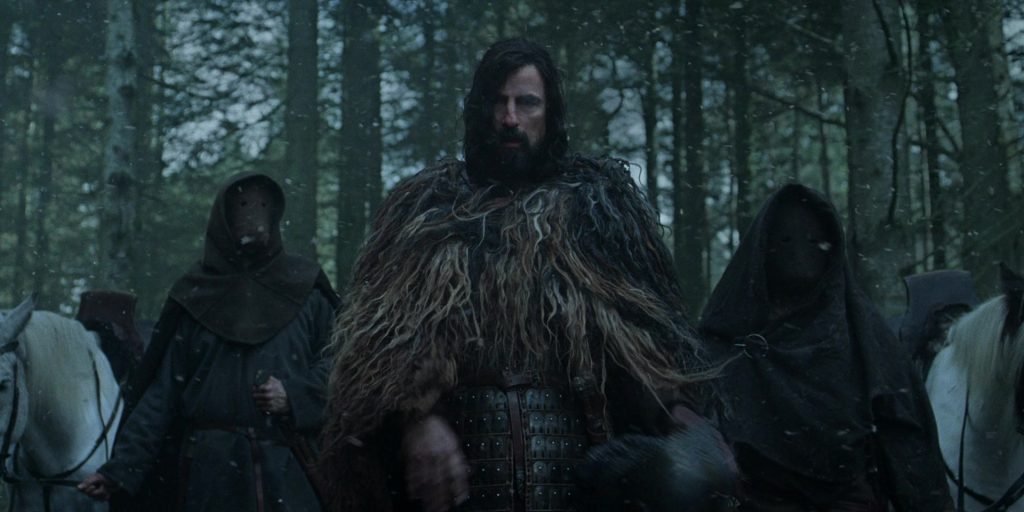
Flashforward to a few years later, and nothing is really going as it should. Amleth is now in the land of the Rus, a historical kingdom that encompassed parts of modern Belarus, Russia, and Ukraine.
He has fallen in with a group of berserkers that make a living of raiding Slav villages and trafficking their people as slaves. Historically, berserkers were a subset of Vikings who worshipped the wolf god Fenrir and were akin to what we might consider “elite warriors”.
They pumped themselves up for battle with shamanic rituals during which they had fly agaric (Amanita muscaria), and wore wolf and bear skins that they believed transferred those animals’ attributes to them.
There is one such ritual scene in the movie where a Viking with a horned-helmet can be seen. While this has a historical basis, the popular culture idea that Vikings usually wore horns is misguided.

Costume designer Linda Muir has said that The Northman was a particularly difficult project, since there are not many Viking garments in museums and we don’t really know that much about Vikings in general.
Also, Viking research is apparently very focused on the more masculinist elements of the culture, so that dressing the female characters was not that easy. She would have to ask the movie’s historical consultant things such as what a Viking woman would wear if she wanted to feel sexy, etc.
The scene where the berserkers raid a Slav village is one of the most hyped ones of the movie. For Eggers, it was very important that the action was easy to follow, and he names a small set of very interesting references.
The most important are Akira Kurosawa’s movies, mainly Seven Samurai and Ran; Ang Lee’s Crouching Tiger, Hidden Dragon; and Ardak Armikulov’s The Fall of Otrar. Whereas Kurosawa, for example, achieves continuity through montage, Eggers strives for the same effect through a continuous take. For this, he also examined the continuous takes in Miklós Jancsó’s The Round-Up.
The sequence ends with the berserkers burning the village’s elderly and children in a barn, a moment that is starkly reminiscent of Elem Klimov’s Come and See – a movie about the effects of war on a young boy and the loss of innocence, so that a parallel can be drawn between the Belarusian youth of that film and The Northman’s Amleth.
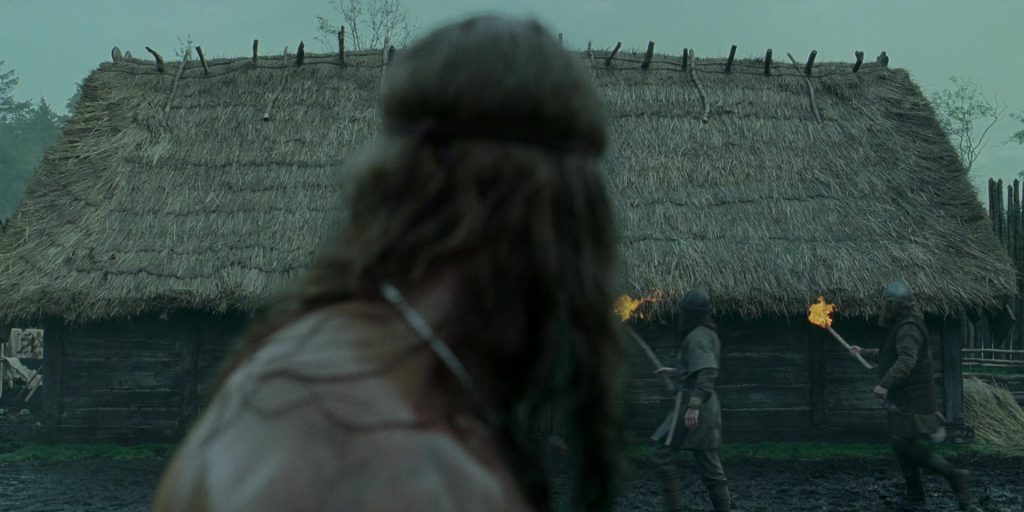
Also, after the raid, a female warrior can be seen looking for “strong ones”. On first watch, I thought she must have been a Valkyrie looking for fallen warriors to take back to Valhalla, but this is apparently not the case.
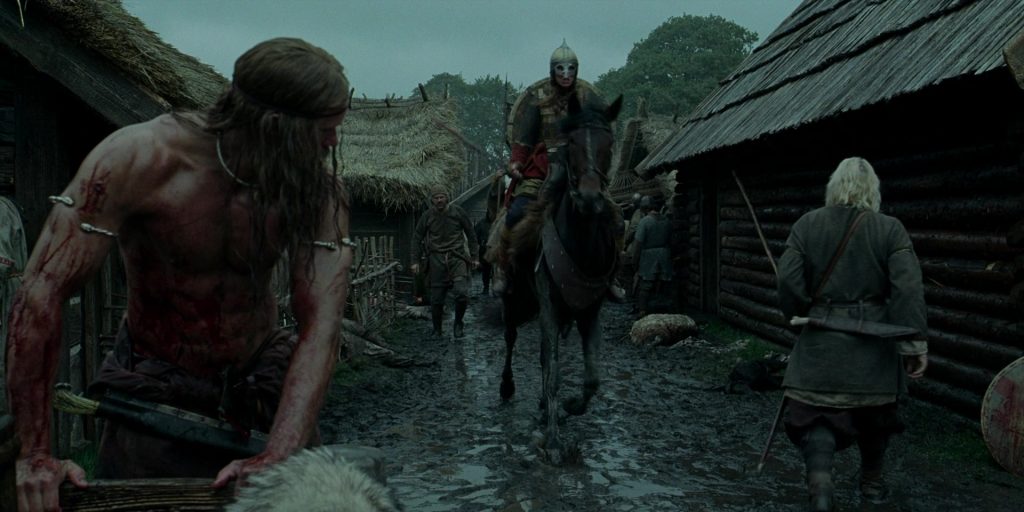
Her character is listed as “shield maiden”, and she represents a Viking warrior. Her design is loosely based on an actual finding, grave BJ581, that was dug up on the Swedish island of Björkö.
Let’s look now at the theme of destiny in the movie. Amleth wanders the village at night until he finds himself in a temple consecrated to Svetovit, the Slav god of abundance and war. He finds a sorceress there who claims that Vikings plucked her eyes out, but there’s more to her than just that.
She can be seen spinning a thread, an action of deep ramifications. In Norse mythology, there was a subset of female deities called the Norns who spun the destinies of both humans and gods. That meant that, as your fate had already been spun, it was set to happen and could not be changed in any manner.

This is very relevant to Amleth as a character since the sorceress, then, seems to also be a Norn spinning his destiny. In fact, she gives him back his “tear” so as to signify that the time has come to fulfil his oath.
Then, she makes a prophecy – Amleth will to a Northern island, where a grey fox will guide him to the blade he’ll use for his revenge. He will have his revenge at a burning lake; and finally, a maiden King will continue his lineage.
This is therefore the destiny that the Norns have in store for him. As we have seen, it is inescapable, because in Eggers’ films, beliefs are reality. And, true enough, Amleth overhears one of his companions talking about Fjölnir.
Fjölnir has been chased away of his kingdom by King Harald I Fairhair of Norway, and is now living in exile in Iceland, where some of the slaves will be taken. And, as Amleth will eventually find out, there is another notable change that has taken place – Fjölnir has had a son, Gunnar, by the Queen, giving Amleth a younger half-brother.
One very poignant different between Amleth and Gunnar is that, while Amleth was conceived through rape, Gunnar was a wanted child that the Queen loves wholeheartedly. Amleth is shown to have conflicting feelings towards Gunnar, as he loves him as a brother, but believes him to have been forced onto his mother – unsuspecting that it is the other way around.
This is most evident during a game of knattleikr that Fjölnir’s people hold, when Gunnar is attacked by a slave but saved by Amleth. (As a side note, knattleikr was a very popular game at the time, and although the exact rules are unknown, nowadays there are in fact tournaments where it is reenacted.)

After Amleth smuggles himself into the boat leaving for Iceland as a slave, thus fulfilling the first part of the prophecy, he follows a grey fox that leads him into a cave where a he-witch lives.
The he-witch keeps with him the mummified head of Heimir the fool, who we learn had been killed by Fjölnir as a punishment for making fun of him and Queen Gudrún.

By using this head, the he-witch is able to communicate with the dead through necromancy, and tells Amleth where he can find the blade he is destined to use – and which he will only be able to unseath at night.
We are now treate to a scene dealing with another aspect of death in Viking culture. The sword is guarded by a draugr, some kind of revenant or proto-vampire that was supposed to live inside a burial mound. Vikings believed that you could tell whether a corpse as a draugr by its position – if it was sitting, it would be able to stand up, and the way to get rid of it would be to cut its head off.
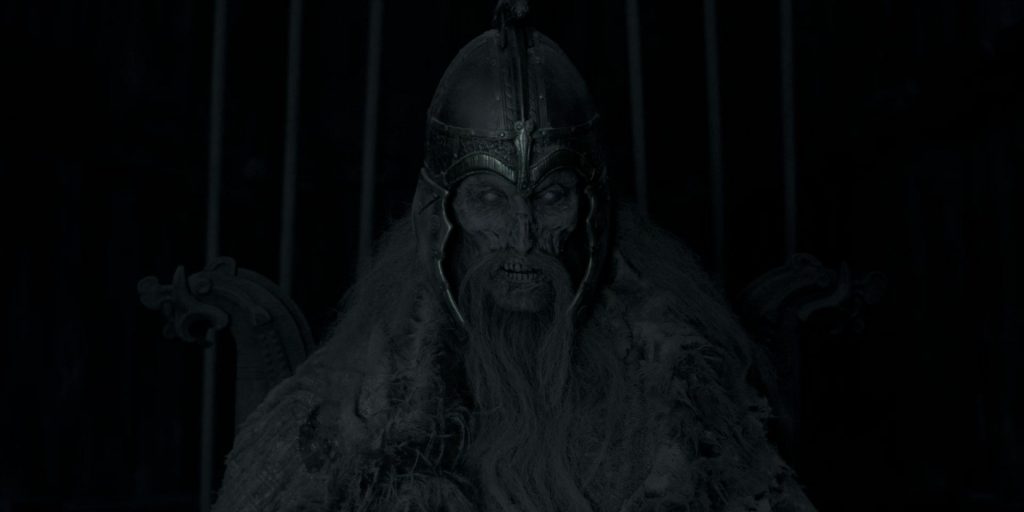
What follows is Amleth slowly bidding his time until he can fulfill the next part of the prophecy – enacting his revenge at a burning lake. Unfortunately for him, there is no burning lake in sight just yet, so he decides to wrack havoc with the help of Olga of the Birch Forest.
Olga is a Slav woman who was taken as a slave during the berserker raid, and she is set on escaping captivity. She sees a chance in Amleth, as he tells her that he has business there, so she partners up with him.
The first part of Amleth revenges sees him killing two of his captors and nailing their bodies to a hut. Interestingly, the Vikings’ first thought is that Christians must have been responsible for the murders, as their god was himself nailed to a cross.
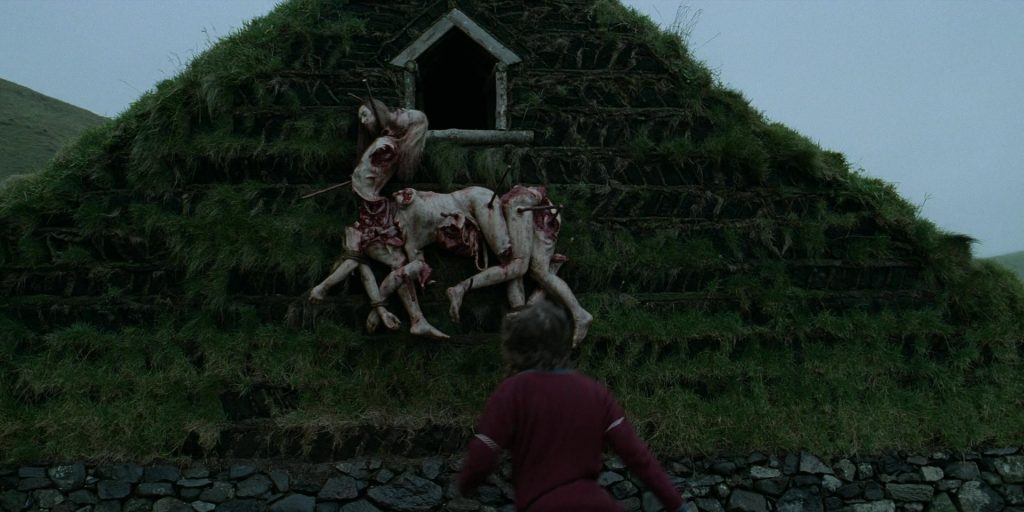
The priestess, however, decides that the incident is probably linked to trollish sorcery, and she decides to sacrifice a slave girl in order to appease the gods, specifically, Freyr. On the night of the sacrifice, Amleth manipulates the dogs into attacking their owners, while Olga mixes hallucinatory mushrooms into the food.
Amleth takes advantage of the ensuing chaos to reveal himself to Queen Gudrún, and it is then that Amleth learns the whole truth. The audience has already had a few glimpses into Fjölnir’s true character, which help see him as a more nuanced individual and not as the absolute monster Amleth considers him to be.
This is evident, for example, in the manner in which Fjölnir tries to teach Gunnar not to shy away from labor, as he needs to prove himself strong to the slaves, the situation being volatile in the Viking world.
Nevertheless, Amleth is enraged at finding out his mother’s betrayal of himself and his father, as well as the real nature of King Aurvandil, and kills Fjölnir eldest son, in a fit of rage.
The funeral scene is again based on real period sources, specifically, on Ibd Fadlan’s grisly 921 account of a chieftain’s funeral. A slave girl was raised three times, while saying these words – “Behold, I see my father and mother. I see all my dead relatives seated. I see my master seated in Paradise, and Paradise is beautiful and green… He calls me. Take me to him.” Then, she was killed.

The actual account is particularly disturbing, as it alludes to horrific sexual violence, but fortunately Eggers decided not to graphically depict that aspect in the film. In any case, rape is alluded to as the motivation behind Queen Gudrún’s actions, and it is also hinted at after the Slav village raid.
It is at this point in the movie that Amleth considers abandoning his oath in order to lead a happier life with Olga, with whom he has now a relationship. As they are ready to leave, however, he has a vision of the Tree of Kings that reveals to him that Olga is pregnant with his twin children.
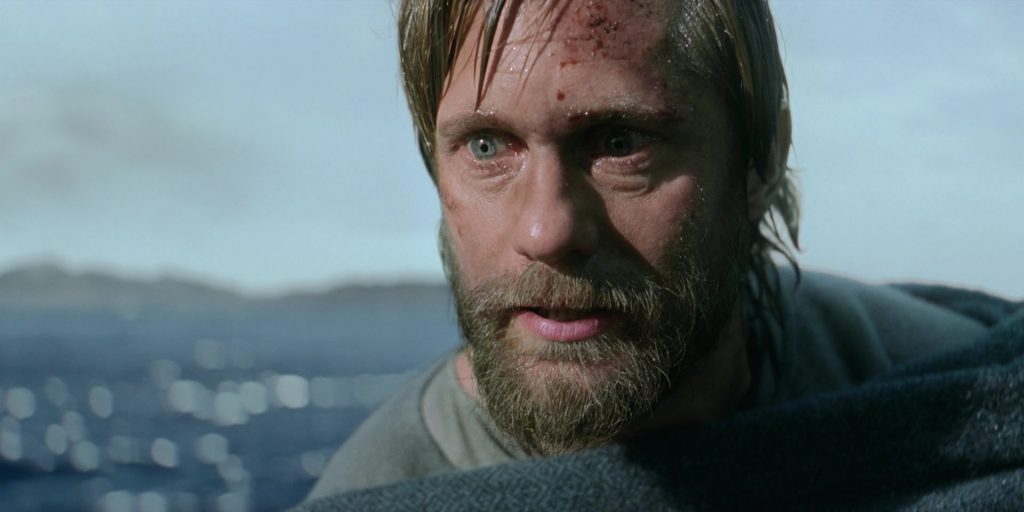
This is where Amleth realizes that he cannot escape his destiny. Since his destiny is to avenge his father, it is better to do so before Fjölnir can take revenge on his children, and thus, Amleth goes back to fight Fjölnir.
Olga, being of Slavic origin and having a completely different set of beliefs, tries to hold him back, although to no avail. It should be noted here that their daughter is made to look like St. Olga of Kiev, Queen regent of Kiev between the years 945 and 969, known mostly by her conversion to Christianity.
This raises up a few questions that are left unanswered: Did she convert to Christianity as a rejection of the beliefs that led her father to his death? Does this imply that the cycle of violence ended with her?

Queen Gudrún and Gunnar attack Amleth and he is forced to killed them in self-defense. The scene where he bids farewell to their corpses and promises that they will all meet at Valhalla adds to the tragedy of Amleth’s story, as his love for his family is very evident.
The movie ends with Amleth and Fjölnir killing each other on a volcano – the burning lake of the prophecy. Amleth is taken to Valhalla by a Valkyrie, and, while he is dying, he has a vision of Olga and their children telling him they are safe.

For more information on the historical accuracy of The Northman, I recommend watching this video by the Welsh Viking, which is also linked to above.
All images belong to their respective authors. Screencaps taken from cap-that.com

